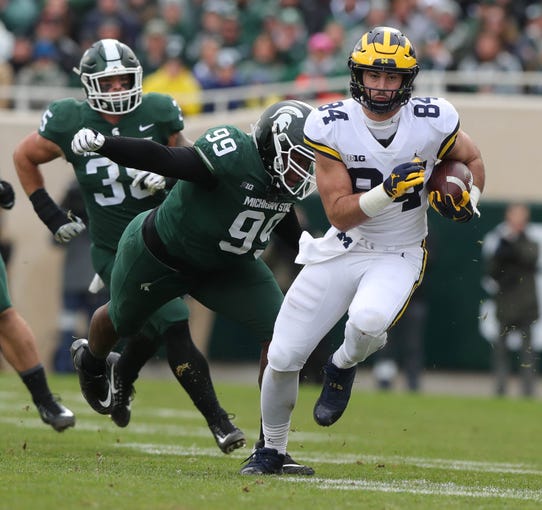 |
| Kirthmon F Dozier, Detroit Free Press |
Building to the Screen Game
This is building within the Dos formation, a formation Wisconsin has heavily featured. The play utilizes two double twins split tight to the LOS. Because of this, it maintains a lot of width along the defensive front, but having two H-backs lined up outside the OTs also allows for a lot of variety in the run game.
When Michigan first showed this formation, they predictably used it to run the football. Here's a basic inside zone play
They've build off the run game as you would expect, running split zone and Counter H (example) and stretch. This predictably resulted in Swap Boot as a nominal iteration. But they also utilized the zone run action to set up their vertical pass game. Here, they have a switch release between the outside WR and the TE and then proceed to run a flood route to the wide side of the field.
Notice the backside WR is going to run a dig, and the backside TE stays in to block.
These are important, because now you establish this as a play action tendency, and as soon as you do that, you can build off of it.
To the wide side of the field you have a switch release into two vertical routes, to the backside, the WR has a vertical release while the backside TE stays in to help block. But he's not really blocking, it's all a set up. This wasn't even the first time Michigan ran this, but it looks just like a tendency they've established in the with the vertical pass game.
Bunch Tendency
All year, when Michigan has gone to bunch, they've shown what you often show (because it's a strength of the bunch formation), switch routes to stress the bracket coverage.
While the concepts with them they utilize with them are different (mesh and yogi, respectively), they both result in the inside receiver releasing outside underneath a vertical route.
The yogi concept itself is an iteration off the earlier mesh route, because it mocks a drag route before whipping back outside. But now this inside receiver outside release tendency is established.
So what do you do? You show an outside release underneath a vertical route, let the defense work over the top, and then slant back inside.
You still attack with your concepts the same zones of the field (hook zone, flat zone, and vertical), but you switch the assignments after giving a certain look with your stem.
Conclusion
The first few steps of a play tell a tale. You have tendencies, and typically you have tendencies for a reason. But your ability to show something, and then build off of it, is fundamental to any successful playbook. Here, you see a few examples of how Michigan is doing that with formation and release.





